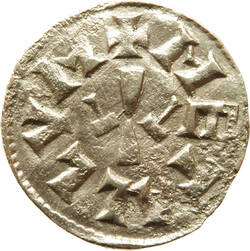In 814, Emperor Charlemagne died and was succeeded by his son, Emperor Louis the Pious. He now inherited the vast realm of the Franks. It stretched from the North Sea coast of Frisia all the way to Northern Spain and took in most of Italy as well. Economically, a territory of that size would obviously display a great deal of structural diversity.
So Louis the Pious decided to adopt the coinage system introduced by his father two decades earlier. As well as minting silver denars, he also added a new coin, the half denar. It was known as a "hälbling" (half penny) or "obol". Like his father, he also issued portrait denars at various mints. They're regarded as rarities, because they were only struck for special occasions. You can see one example here.
The obverse shows the emperor's title and bust with laurel wreath. That's very much in the tradition of coins issued by Roman emperors. The reverse shows images of two coining dies and two hammers. The Latin circumscription reads METALLUM, a reference to the place where the coin was produced: Melle Mint in what is now western France. The region once had large silver deposits, which were processed into coinage at one of the most important Carolingian mints – as witness the minting tools depicted on the reverse.
Further Media
- Location & Dating
- Frankish Empire, n.d. (814-819)
- Material & Technique
- Silver, embossed
- Dimenions
- Diameter: 19,7 mm; weight: 1,62 g
- Museum
- Münzkabinett
- Inventory number
- AUB6536
